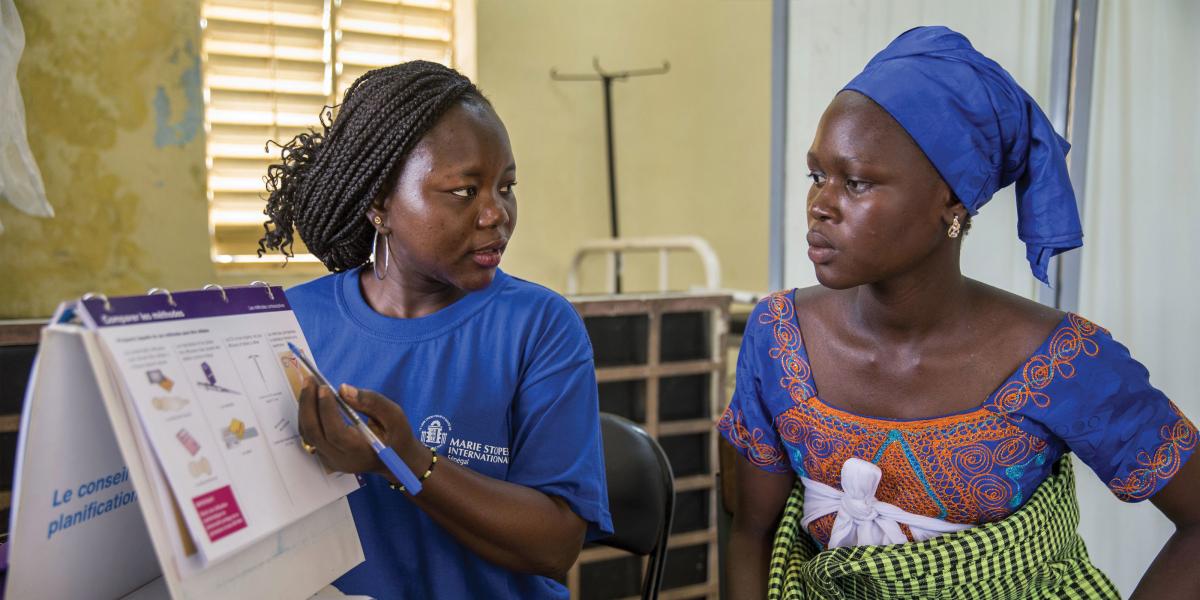Toward Universal Family Planning
Expanding access at a pivotal moment in the movement
An astounding 21st-century fact: Nearly half of all pregnancies worldwide are unintended.
Despite decades of progress that transformed the family planning landscape since the 1960s, an estimated 257 million people hoping to avoid pregnancy today are not using modern contraceptive methods, according to the UN Population Fund. Of those, 172 million use no form of family planning at all.
The impacts of unintended pregnancies include high maternal death rates and poor child survival rates, especially among the world’s most vulnerable. Unintended pregnancies, unsafe abortions, and maternal deaths would drop by about two-thirds if all women in low- and middle-income countries had access to effective family planning methods, according to the Guttmacher Institute.
What’s holding back progress? Misinformation, stigma, and opposition from spouses, family members, religious leaders, policymakers, and others can all undercut women’s ability to use family planning and achieve their reproductive goals. Understaffed, undersupplied family planning clinics in remote locations also make access a challenge. And insufficient government funds put these services further out of reach.
One potential solution: Integrate family planning and reproductive health services into burgeoning universal health coverage (UHC) initiatives—so they are part of primary health care services offered in district hospitals and local clinics.
“People naturally think of health care facilities when they need health care. It’s more efficient to eliminate parallel systems. Community financing options, even on a very small scale, have done well and been very acceptable,” says Funmilola OlaOlorun, MBBS, PhD ’13, MPH, who serves as co-principal investigator for Performance Monitoring for Action (PMA)/Nigeria.
The pandemic offered a glimpse of how this can work. Governments in several sub-Saharan African countries, including Kenya, Tanzania, and Uganda, designated family planning as an essential service in their response efforts. Local health officials worked with local pharmacies to distribute oral contraceptives, emergency contraception, and condoms—measures credited with helping to maintain steady rates of contraceptive use amid pandemic disruptions.
“One of the confounding things is that we were able to preserve family planning in the first years of COVID-19,” says Beth Fredrick, executive director of Advance Family Planning, a global initiative of the Bill & Melinda Gates Institute for Population and Reproductive Health at the Bloomberg School. She credits the years-long effort by local advocates with AFP and other groups to expand governments’ ownership of the agenda.
The pandemic also brought about innovations, such as telehealth care delivery or community-based distribution of family planning methods, to new locations, says Celia Karp, PhD ’20, an assistant scientist in Population, Family and Reproductive Health. “Thinking about those efforts [to improve family planning] being adopted as standard practices now illustrates an opportunity to potentially enhance the delivery of UHC, drawing on lessons learned from COVID-19,” Karp says.
It’s a pivotal moment for family planning advocates. Some have zeroed in on UHC as a natural pathway to steel family planning services against the whims of politics and pandemics. They make a persuasive case: Not only does including family planning services in UHC programs help ensure access to everyone in need, it makes good financial sense. Every dollar spent on contraceptive services (beyond current spending) could reduce pregnancy and newborn care costs by $3, according to a Guttmacher Institute estimate.
But Fredrick and others worry that funds dedicated to family planning prior to the pandemic may not be replenished. “Now that we’re getting into the longer term, things are shifting … and it’s not clear that the commitment is taking hold,” Fredrick says. Continued support for local advocates will be key, she says, to ensuring governments continue to invest in family planning.
Thailand, host of the International Conference on Family Planning in November (see sidebar), offers a compelling model. Long a proponent of family planning, the country rolled out a UHC plan in 2002 that delivered universal access to essential health services at no cost to all citizens. As part of the effort, Thailand expanded access to sexual and reproductive health services in primary health care—placing a family planning clinic within all government hospitals; providing family planning training to all midwives, nurses, and doctors; and covering the cost of contraceptives. While UHC isn’t the sole reason for Thailand’s success, contraceptive use among all women in the country climbed from 15% to 70% between 1971 and 2019. In addition, between 2000 and 2017, the maternal mortality ratio decreased from 43 per 100,000 live births in 2000 to 37 in 2017, The World Bank also noted.
Other countries, however, have less consistent political support for integrating family planning services in UHC. The Challenge Initiative (TCI), another Gates Institute–led program, supports local governments in urban areas across 12 countries to take the lead in scaling up high-impact family planning interventions. TCI also advocates for city health ministries to dedicate their own funds to family planning services—and several cities have already “graduated” to sustainability.
For example, Kenya’s Kilifi County is making remarkable progress despite being dogged by health challenges including a high rate of teenage pregnancies, according to Paul Nyachae, MPH, TCI’s project director for East Africa. “When we started the program, the county did not have a budget to run family planning as an independent program in line with their health strategy; by the end, it did—along with a significant increase in the health ministry’s financial commitment,” he says. County officials credit the partnership with reducing the county’s rate of pregnancies among adolescents ages 10–19 from 31% in 2020 to 14% by mid-2021.
Tremendous challenges—starting with a lack of political will—remain across East Africa. But seeing other cities’ success has helped persuade more leaders to come on board. “The left-behind cities can see what they’re missing. Our goal is to support greater self-reliance of local governments, leading to sustained improvement in urban health systems and inspiring them to move their programs much further,” Nyachae says.
